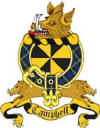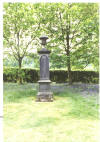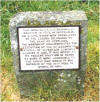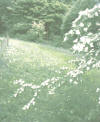|
INVERARAY
Home of the Duke of Argyll – Mac Cailein Mor and Chief of
Clan Campbell

I live in
the North West of England about 300 miles or so from the
Western Highlands of Scotland and Inveraray Castle, home of
the Duke of Argyll, and Mac Cailein Mor, Chief of Clan
Campbell. I have been fortunate to visit the town
and the castle a few times, so I thought I should share
the experience with others less able to make the trip.
The road to
Inveraray from Oban takes you down the southern end of
Loch Etive, through the Pass of Brander and around the
north east end of Loch Awe where (at the southern end) on
the Isle of Innischonnel, was the original Campbell
stronghold until the mid 15th century. The road then is
into the quiet and beautiful Glen Aray which on a sunny
day is an inviting place to bide a while and enjoy a
picnic and the surroundings views. Inveraray is a small
town on the shore of Loch Fyne. It is particularly
attractive from the seaward view giving the impression
that it is bigger than it actually is, but it has an
undeniable character in its buildings and general air The
old town and castle of Inveraray used to be located on the
banks of the River Aray close by the shore . The town was
referred to in 1768 as “composed of t he he
most wretched hovels… ” and it is to the 3rd Duke,
Archibald’s credit that when he planned to rebuild the
castle in the mid 1700s he swept away the squalor and
founded the new town roughly a mile away. Inveraray was
originally a burgh or barony under the Argyll family but
was given Royal Burgh status by Charles I in 1648.
The town
itself has quite a tale to tell. The Parish church for
example is unique in having two halls, one for the service
in English and the other in Gaelic. There is also the Town
Cross which was brought from Iona and inscribed in Gaelic
the English translation of which is:
This
is the cross of the noble men, namely Duncan MacCom,
Patrick his son, and Ludovick the son of Patrick, who
caused this cross to be erected.
The main
occupation of Inveraray used to be herring fishing and the
harbour was anciently called “Sloch a Chopper ” – the
gullett where vessels barter fish. A curious expression
but descriptive of its activities none the less. The town
arms is a net with herring, the latin motto “Semper tibi
pendeat halec” translated as – may a herring always hang
to thee.
The Montgomery
Manuscripts gives an explanation of the origin
of the Campbell name and there is also an interesting tale
told how the land for the first castle was acquired in the
fourteenth centry by a little bit of sharp practice. The
family had been given a tract of land on the eastern shore
of Loch Fyne but coveted land on the opposite shore. Mac
Ceilean Mor bargained with the McVicars, who owned the
land, for as much land as could be covered by the skin of
a foal, and, cutting the skin into thin ribbons and tying
them together, measured and took possession of a
considerable area. Work on the new castle was commenced in
1745 and finished about 1758 although decoration inside
continued for many years thereafter.
 The The
castle was designed by Roger Morris and built of a locally
quarried blue – grey chlorite slate which has the
particular quality that after a shower it looks quite
black, but soon returns to its original blue – grey as it
dries off. The building is quadrangular basically two
storied with a sunken floor to which there have been
additions over the years. There are rounded towers with
conical roofs (added by the 8th Duke in 1877-78) and a
square tower in the centre. The net effect is an almost
fairy tale type of castle and the whole set in spacious
park land and meadow through which the River Aray flows
under a bridge designed by John Adam. Overlooking the
castle is the Duniquaich , a cone shaped hill with a
monument on top that was originally said to be a watch
tower from which the Dukes could keep an eye on those
entering Inverarary.
Within the
grounds there is now the memorial to
 seventeen seventeen
Campbells, the Martyrs, who were executed locally for
having supported the 9th Earl of Argyll and the Duke of Monmouth in their uprisings against James II in 1685. Monmouth was a favourite and
General of the Army but was exiled for involvement in a
scheme to kill King Charles II and his brother James ( the Rye House Plot). Argyll returned to Scotland as part of a joint rebellion, but failed to raise support; he was taken and executed as his father before him. Monmouth
returned and was defeated at the battle of Sedgemoor soon
after he landed, and executed at Tower Hill in London. The
memorial used to be in a garden in the town but was
relocated to the Castle grounds un 1983. The plaque reads:
This
monument was originally erected in 1754 in Inveraray on
a site which now forms part of the garden of the Bank of
Scotland. The monument commemorates the execution by the
1st Marquess of Atholl of seventeen Campbell
leaders in 1685. It was moved to its present position in
order to make it more accessible to the public and where
it was unveiled by the 10th Duke of Atholl in 1983.
 Inside Inside
the castle there are to be seen a wide variety of objects
and art to which mere words cannot do justification. As
perhaps should be expected of a distinguished family there
are many mementoes as in the Armoury Hall where there are
displays of arms. These include a selection of 16th and
17th century spears/lances, Brown Bess muskets, the huge
war axes, and the equally huge broadswords that must have
required a strong arm to wield. Amongst the displays there
is also Rob Roy’s sporran, belt and handle of his dirk.
The
Tapestry Room contains original ( 200 year old) Beauvais
tapestries and with it there is a fine selection of
furniture from the late 18th century There are
decorations, panels, lavishly ornamented ceilings and rich
painting everywhere, and many family portraits by leading
artists of their day. The China Turret has a splendid
collection of Japanese Imari ware as well as Meissen,
Worcester and Derby pieces. The Victorian Room includes,
amongst other things, a writing desk that Queen Victoria
gave to her daughter, Princess Louise on her marriage to
the Marquis of Lorne, later the 9th Duke, in 1871.
The
inimitable Dr. Johnson, who visited Inveraray in 1773,
said
to Boswell: “what I admire here, is a total defiance of
expense”. There are not many places where you can see a
designer made castle, designer made grounds and bridge and
a designer made town for good measure. I would say idyllic
sums it up.
I hope this
thumbnail sketch and views give you a taste of what lies
ahead should you make a trip to Inveraray. It is a must
for any Clansman visiting Scotland.
Next :
Campbeltown and Kintyre.
|